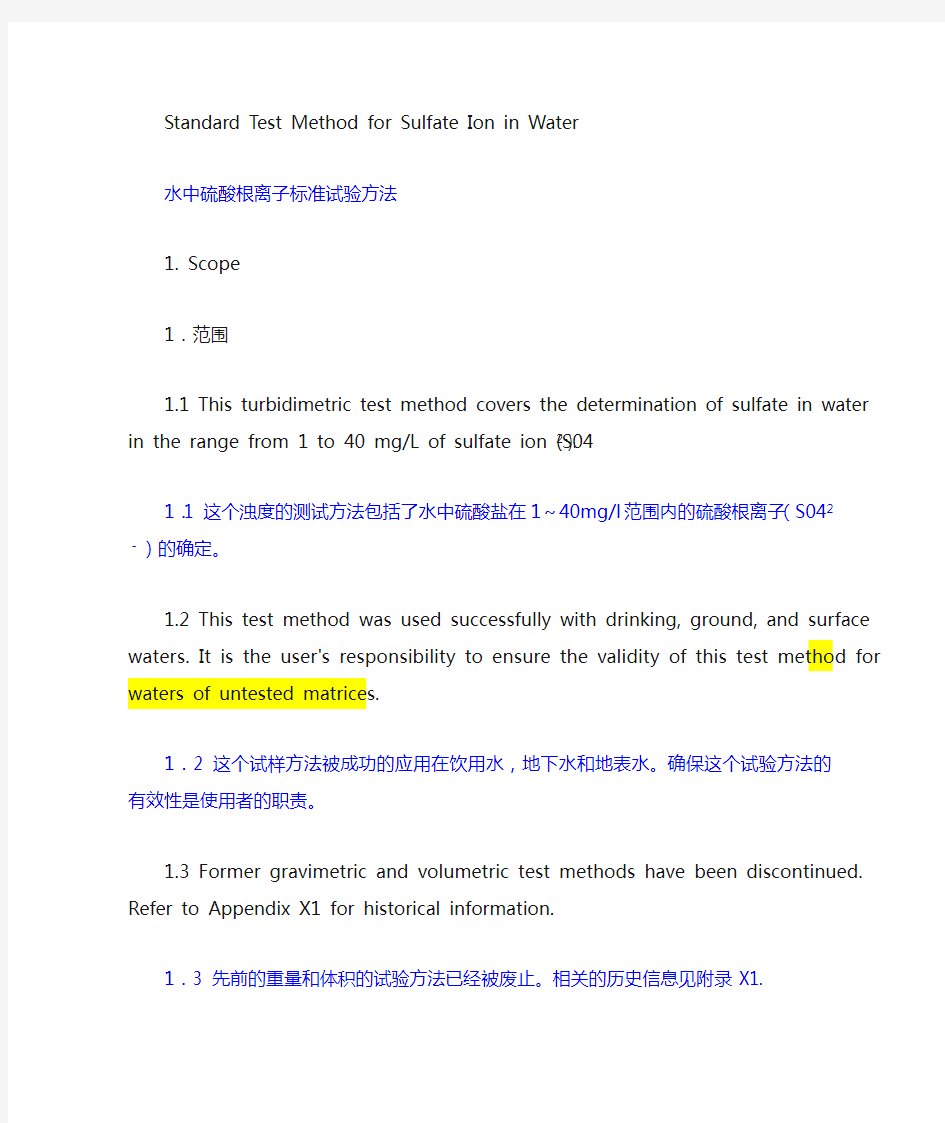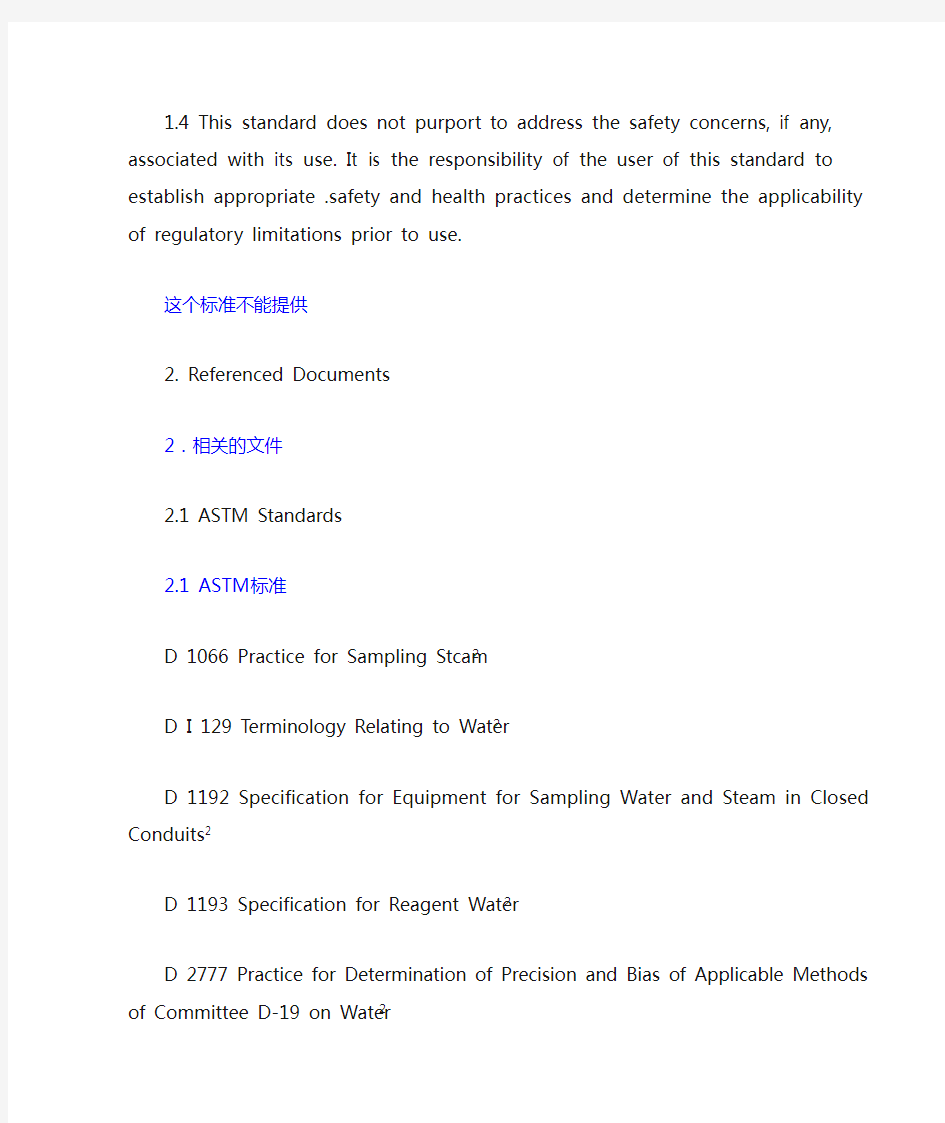ASTM水中硫酸根离子标准试验方法


Standard Test Method for Sulfate Ion in Water
水中硫酸根离子标准试验方法
1. Scope
1.范围
1.1 This turbidimetric test method covers the determination of sulfate in water in the range from 1 to 40 mg/L of sulfate ion (S042-).
1.1 这个浊度的测试方法包括了水中硫酸盐在1~40mg/l范围内的硫酸根离子(S042-)的确定。
1.2 This test method was used successfully with drinking, ground, and surface waters. It is the user's responsibility to ensure the validity of this test method for waters of untested matrices.
1.2 这个试样方法被成功的应用在饮用水,地下水和地表水。确保这个试验方法的有效性是使用者的职责。
1.3 Former gravimetric and volumetric test methods have been discontinued. Refer to Appendix X1 for historical information.
1.3 先前的重量和体积的试验方法已经被废止。相关的历史信息见附录X1.
1.4 This standard does not purport to address the safety concerns, if any, associated with its use. It is the responsibility of the user of this standard to establish appropriate .safety and health practices and determine the applicability of regulatory limitations prior to use.
这个标准不能提供
2. Referenced Documents
2.相关的文件
2.1 ASTM Standards
2.1 ASTM标准
D 1066 Practice for Sampling Stcam2
D I 129 Terminology Relating to Water2
D 1192 Specification for Equipment for Sampling Water and Steam in Closed
Conduits2
D 1193 Specification for Reagent Water2
D 2777 Practice for Determination of Precision and Bias of Applicable Methods of Committee D-19 on Water2
D 3370 Practices for Sampling Water from Closed Conduits2
D 5847 Practice for Writing Quality Control Specifications for Standard Test Methods of Water Analysis3
E 60 Practice for Photometric and Spectrophotometric Methods for the Chemical Analysis of Metals4
E 275 Practice for Describing and Measuring Performance of Ultraviolet, Visible, and Near Infrared Spectrophotometerss
3. Terminology
3.术语
3.1 Definitions-For definitions of terms used in this test method, refer to Terminology D 1129.
3.1 定义――对于用于这个试验方法的术语定义,请见术语学D1129。
4. Summary of Test Method.
4.试验概述
4.1 Sulfate ion is converted to a barium sulfate suspension under controlled conditions. A solution containing glycerin and sodium chloride is added to stabilize the suspension and minimize interferences. The resulting turbidity is determined by a nephelometer, spectrophotometer, or photoelectric colorimeter and compared to a curve prepared from standard sulfate solutions.
4.1对于受控制的条件下硫酸钡悬浊液,硫酸根离子是可修改的。一份包含甘油和氯化钠的溶液被加到里面,用来稳定悬着物和最小化干涉。用浊度计,分光光度计,或者光电比色计确定混浊度的结果,对比一条已经从标准的硫酸盐溶液准备好的曲线。
5. Significance and Use
5.意义和利用
5.1 The determination of sulfate is important because it has been reported that when this ion is present in excess of about 250 mg/L in drinking water, it causes a cathartic action (especially in children) in the presence of sodium and magnesium, and gives a bad taste to the water.
5.1 硫酸盐的确定是很重要的,因为它已经被报道,当这种离子(以钠盐和镁盐形式出现)在饮用水中含量超过大约250 mg/l时,它将引起一个导泻作用(尤其是在孩子身上),并且对于水有一种不好的滋味。
6. Interferences
6.干涉
6.1 Insoluble suspended matter in the sample must be removed. Dark colors that can not be compensated for in the procedure interfere with the measurement of suspended barium sulfate (BaS04).
6.1 试样中不能溶解的悬浮的物质必须被分离。在这个步骤中,不能被补偿的黑颜色会干扰硫酸钡悬着液的测定。
6.2 Polyphosphates as low as 1 mg/L will inhibit barium sulfate precipitation causing a negative interference.
6.2 象1 mg/L一样低的多磷酸盐将阻止硫酸钡沉淀,由负干涉引起。
Phosphonates present in low concentrations, depending on the type of phosphonate, will also cause a negative interference.
磷酸盐在低浓度的凝聚物中存在情况(取决于磷酸盐的种类),仍然由负干涉引起。
Silica in excess of 500 mg/L may precipitate along with the barium sulfate causing a positive interference.
超过500 mg/L的二氧化硅可以随着硫酸钡沉淀而沉淀,由正干涉引起。
Chloride in excess of 5000 mg/L will cause a negative interference.
超过5000 mg/L的氯化物将引起负干涉。
Aluminum, polymers, and large quantities of organic material present in the test sample may cause the barium sulfate to precipitate nonunifonnly.
存在于试验样品中的铝化物,高分子材料和大量的有机物,可以引起硫酸钡不均匀的沉淀。
In the presence of organic matter certain bacteria may reduce sulfate to sulfide.
有机物中某种细菌的存在,可以还原硫酸盐到硫化物。
To minimize the action of sulfate reducing bacteria, samples should be refrigerated at 4℃when the presence of such bacteria is suspected.
为了最小化由细菌还原硫酸盐的作用,当样品种被怀疑有这样的细菌存在时,样品应该冷却在4℃。
6.3 Although other ions normally found in water do not appear to interfere, the formation of the barium sulfate suspension is very critical.
Determinations that are in doubt may be checked by a gravimetric method in some cases, or by the procedure suggested in Note 2.
6.3 尽管在水中正常发现的其他离子看起来不参加干涉,但硫酸钡悬着液的构成是很临界的。
在很多情况下,存在疑问的测定可能用重量分析方法或按注2中的程序被检查。
7. Apparatus
7.器具
7.1 Photometer-One of the following which are given in order of preference.
7.1 光度计-下面给出的按优先次序选择的一种仪器
7.1.1 Nephelometer or turbidimeter;
浊度计或浊度表
7.1.2 Spectrophotometer for use at 420 nm with light path of 4 to 5 cm;
分光光度计,它能用于测定420nm,有4~5cm的光径。
7.1.3 Filter photometer with a violet filter having a maximum near 420 nm and a light path of 4 to 5 cm.
滤光光度计,它有接近420nm的紫色滤光片和4~5cm的光径。
7.2 Stopwatch, if the magnetic stirrer is not equipped with an accurate timer.
秒表,假如磁性搅拌器没有装备上一个精确的计时器。
7.3 Measuring Spoon, capacity 0.2 to 0.3 mL.
测量勺子,0.2~0.3 mL容量。
7.4 Filter photometers and photometric practices prescribed in this test method shall conform to Practice E 60; spectrophotometer practices shall conform to Practice E 275.
在这个试验方法中的滤光光度计和光度计指定规范应该遵从E60惯例;分光光度计惯例应该遵从E275惯例。
8. Reagents
8.试剂,反应物
8.1 Purity of Reagents-Reagent grade chemicals shall be used in all tests. Unless otherwise indicated, it is intended that all reagents shall conform to the specifications of the Committee on Analytical Reagents of the American Chemical Society. Other grades may be used, provided it is first ascertained that the reagent is of sufficiently high purity to permit its use without lessening the accuracy of the determination.
8.1 试剂纯度-试剂的等级化学药品应该被用于所有的测试中。除非其他的被指定,所有的试剂都应该遵从美国化学药品界的试剂分析委员会的技术标准。在不减轻测定的精度情况下,其他等级的也可以被应用,倘若首先确认的是这样的试剂有足够高的纯度来允许它的使用。
8.2 Purity of Water-Unless otherwise indicated, reference to water shall be understood to mean reagent water conforming to Specification D 1193,
Type I. Other reagent water types may be used provided it is first ascertained that the water is of sufficiently high purity to permit its use without adversely affecting the precision and bias of the test method.
Type II water was specified at the time of round robin testing of this test method.
8.2 水的纯度――除非其他的被指定,涉及到的水应该被理解为去平均试剂的水(遵从D1193规范)。类型I,在不反作用于精度和偏离试验方法的情况下,其他类型试剂水也可以被应用,倘若首先确认的是这样的水有足够高的纯度来允许它的使用。
8.3 Barium Chloride-Crystals of barium chloride (BaCl2·2H2O) screened to 20 to 30 mesh. To prepare in the laboratory, spread crystals over a large watch glass,
desiccate for 24 h, screen to remove any crystals that are not 20 to 30 mesh, and store in a clean, dry jar.
8.3氯化钡――通过20~30号筛的氯化钡晶体。在实验室准备时,在一个大的观察玻璃上撒播晶体,为了使它在24小时后变干,除去不是20~30号筛范围内的任何晶体,并且在一个干净干燥的广口瓶中贮藏它们。
8.4 Conditioning Reagent-Place 30 mL of concentrated hydrochloric acid (HCl, sp gr 1.19), 300 mL reagent water, 100 mL 95% ethanol or isopropanol and 75 g sodium chloride (NaCl) in a container. Add 50 mL glycerol and mix.
8.4 试剂条件――在一个容器中放入30ml的浓盐酸(HCl, sp gr 1.19),300ml 试剂水,100ml95%的酒精或异丙醇和75克氯化钠(NaCl)。然后添加50ml甘油并混合它们。
8.5 Sulfate Solution, Standard (1 mL=0.100 mgSO42-)-Dissolve 0.1479g of anhydrous sodium sulfate (Na2S04) in water, and dilute with water to 1 L in a volumetric flask.
8.5 标准的硫酸盐溶液(1 mL=0.100 mgSO42-)――在量筒(一个测定体积的瓶)里,溶解0.1479g的无水硫酸钠到水中,然后用水稀释到1L。
9. Sampling
9.试样
9.1 Collect the sample in accordance with Practice D 1066, Specification D 1192, and Practices D 3370, as applicable.
按照D1066,D1192,D3370标准或者其他可以适用的标准收集试样。10. Calibration
10.校准
10.1 Follow the procedure given in Section II, using appropriate amounts of the standard sulfate solution prepared in accordance with 8.5 and prepare a calibration curve showing sulfate ion content in milligrams per litre plotted against the corresponding photometer readings (Note 1).
10.1 根据第二部分给出的程序,用适当数量的标准硫酸盐溶液去准备与8.5一致的试样,而且准备一个校准曲线(按相应的光度计读数出成图表(NOTE1)),
它能反应每升溶液中硫酸根离子含量。
Prepare standards by diluting with water 0.0, 2.0, 5.0, 10.0, 15.0, 20.0, 30.0, and 40.0 mL of standard sulfate solution to 100-mL volumes in volumetric flasks.
在量筒(一个测定体积的瓶)里,用水稀释0.0, 2.0, 5.0, 10.0, 15.0, 20.0, 30.0, and 40.0 mL标准硫酸盐溶液到100ml体积。
These solutions will have sulfate ion concentrations of 0.0, 2.0,5.0, 10.0, 15.0, 20.0, 30.0, and 40.0 mg/L (ppm), respectively.
这样的溶液将分别包含0.0, 2.0,5.0, 10.0, 15.0, 20.0, 30.0, and 40.0 mg/L (百万分率)的凝聚物。
Note 1--A separate calibration curve must be prepared for each photometer and a new curve must be prepared if it is necessary to change the cell, lamp, or filter, or if any other alterations of instrument or reagents arc made. Check the curve with each series of tests by running two or name solutions of known sulfate concentrations. 11. Procedure
11.程序,步骤
11.1 Filter the sample if it is turbid, and adjust the temperature to between 15 and 300℃.
11.1假如水样混浊,就过滤一下,而且调整水温到15~300℃之间。
11.2 Pipet into a 250-mL beaker 100 mL or less of the clear sample containing between 0.5 and 4 mg of sulfate ion (Note 2). Dilute to 100 mL with water if required,and add 5.0 mL of conditioning reagent (Note 1).
11.2用吸量管吸到一个250ml的广口瓶中100ml或者更少的干净的水样,里面包含0.5~4mg的硫酸根离子(NOTE2)。如果需要,用水稀释到100ml,然后添加5ml需要的试剂(NOTE1)
Note 2-The solubility of BaS04 is such that difficulty may be experienced in the determination of sulfate concentrations below about 5 mg/l (ppm). This can be overcome by concentrating the sample or by adding 5 mL of standard sulfate solution (1 mL=0.100 mg SO42-) to the sample before diluting to 100 mL. This will add 0.5 mg SOQ to the sample, which must be subtracted from the final result.
11.3 Mix in the stirring apparatus.
11.3在搅拌器中混合;
11.4 While the solution is being stirred, add a measured spoonful of BaCl2
crystals (0.3 g) and begin timing immediately.
11.4 随着溶液的被搅动,添加一标准匙氯化钡晶体(0.3g),并且立即开始计时。
11.5 Stir exactly 1.0 min at constant speed.
11.5 以匀速搅动1分钟整。
Note 3--The stirring should be at a constant rate in all determinations. The use of magnetic stirrer has been found satisfactory for this purpose.
11.6 Immediately after the stirring period has ended, pour solution into the cell and measure the turbidity at 30-s intervals for 4 min. Record the maximum reading obtained in the 4-min period.
11.6 在搅动周期结束时立即把溶液倒到浮选机中,测定其混浊度(4分钟内30秒为一个间隔)。记录下在这4分钟的周期内获得的最大读数。
11.7 If the sample contains color or turbidity, run a sample blank using the procedure 11.2 through 11.6 without the addition of the barium chloride.
11.7 如果水样包含颜色或者混浊物,在不添加氯化钡的情况下,按程序(步骤)11.2~11.6再做一次。
11.8 If interferences are suspected, dilute the sample with an equal volume of water, and determine the sulfate concentration again. If the value so determined is one half that in the undiluted sample, interferences may be assumed to be absent.
11.8 假如怀疑有干扰,用相同体积的水稀释样品并再次确定硫酸盐浓度。如果确定的体积是未稀释样品中一倍半,干扰可以被认为不存在。
12. Calculation
12.1 Convert the photometer readings obtained with the sample to milligrams per liter sulfate ion (SO42-) by use of the calibration curve described in Section 10.
12.计算
12.1 利用第10部分描述的校准曲线,转换由试样获得的光度计读数为毫克每升硫酸根离子。
13. Precision and Bias 7
13. 精度和偏差
13.1 The precision and bias data presented in this test method meet the
requirements of Practice D 2777-86.
13.1 在这个试验方法中出现的精度和偏差满足D2777-86标准的需要。
13.2 The overall and single-operator precision of the test method, within its designated range, varies with the quantity being tested according to Table 1 for reagent water and Table 2 for drinking, ground, and surface waters.
13.2 在指定的范围内,这个试验的全部或单一的操作步骤精度,和试验的数量(参照表1为试样水标准和表2为饮用水,地下水与地表水标准)一样变化着。
13.2.1 Seven laboratories participated in the round robin at three levels in triplicate, making a total of 21 observations at each level for reagent water and for matrix water (drinking, ground, and surface water).
13.2.1 参加到这个试验的7个试验室,会在每层为试剂水和杂基水(饮用水,地下水和地表水)得到总数为21个的观测数据。
13.3 Recoveries of known amounts of sulfate from reagent water and drinking, ground, and surface waters are as shown in Table 3.
13.3 从试剂水和饮用水、地下水与地表水中回收的已知的硫酸盐总量,应该与表3中一样。
13.3.1 A table for estimating the bias of the test method through its applicable concentration range can be found in Table 4.
13.3.1在表4中是适用的浓度范围数据,通过它可以评估这个试验的偏差。
13.3.2 These collaborative test data were obtained on reagent grade water and natural waters. For other matrices, these data may not apply.
13.3.2 从试剂等级的水和自然水上获取这些合适的试验数据。在其他的材料上,这些数据可能不适用。
13.4 Precision and bias for this test method conforms to Practice D 2777-86, which was in place at the time of collaborative testing. Under the allowances made in 1.4 of D2777-98, these precision and bias data do meet existing requirements for inter-laboratory studies of Committee D19 test methods.
13.4 这个试验中的精度和偏差遵从于D2777-86标准,在合适的试验次数
下它是合适的。在D2777-98中的1.4的允许下,这些精度和偏差数据必须满足现有的D19试验方法委员会的联合试验室研究成果。
14. Quality Control (QC)
14.质量控制
14.1 The following quality control information is recommended for the determination of sulfate ion in water.
下列质量控制信息为水中硫酸根离子的测定所推荐的。
14.1.1 The instrument should be calibrated using a minimum of four calibration standards and a calibration blank. The calibration correlation coefficient shall be equal to or greater than 0.990.
利用四个校准标准中最小的一个和一个校准表格,校准试验仪器。校准相关系数应该等于或大于0.990.
In addition to the initial calibration blank, a calibration blank should be analyzed at the end of the batch run to ensure contamination was not a problem during the batch analysis.
除了最初的校准表格以外,一个校准表格应该在这组试验完毕后被分析,以确保混合物在组分析过程中不是个问题。
14.1.2 An instrument check standard should be analyzed at a minimum frequency of 10% throughout the batch analysis. The value of the instrument check standard should fall between 80 and 120% of the true value.
在整组试验分析中,最小频率为10%的一组仪器检查标准应该被分析。仪器体积检查标准应该在真实体积的80~120%之间晃动。
14.1.3 Two method blanks should be prepared ensuring that an adequate method blank volume is present for a minimum of seven repetitive analysis.
两种方法的表格应该被准备,确保为一个最小为7次的反复分析提供足够的试验表格卷。
The standard deviation of the method blank is used to determine the minimum detectable concentration of each sample and control in the batch.
标准偏差表格通常用于测定每个样品最小的可发觉的浓度和控制一组样品
的最小的可发觉的浓度。
14.1.4 A Laboratory Control Sample should be analyzed with each batch of samples at a minimum frequency of 10%.
试验室控制样品应该被分析,每组样品的分析频率最小在10%。
14.1.5 If the QC for the sample batch is not within the established control limits, reanalyze the samples or qualify the results with the appropriate flags, or both. (See Practice D5847.)
如果试样组的质量控制不在已制定的管理限制内,重新分析试样或者利用适当的标记使结果具有资格,或者两者都实施(见D5847标准)。
14.1.6 Blind control samples should be submitted by an outside agency in order to determine the laboratory performance capabilities.
为了确定这个试验室的执行能力,Blind control样品应该被一家外部机构提交。
15. Keywords
15.关键词
15.1 drinking water; ground water; sulfate; surface water; turbidimetric.
饮用水,地下水,硫酸盐,地表水,浊度计。
